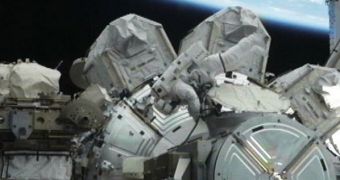Yesterday, February 28, the robotic arm of the International Space Station (ISS) suffered a malfunction during the first extravehicular activity (EVA) of the STS-133 mission. One of the two astronauts carrying out the spacewalk was stuck on the device for a short period of time.
It is now believed that a system failure was responsible for the glitch. It is customary for astronauts to use the Canadarm 2 robotic arm during EVA missions. The arm was developed by the Canadian Space Agency (CSA).
The way this works is fairly straightforward. The robotic arm has a small plate at the end, to which an astronaut attaches their boots. One of their colleagues inside the ISS then operates the arm accordingly.
It is used to facilitate movement, and to ensure that the massive numbers of tasks that usually need to be tackled within a single spacewalk can be completed by two astronauts working alone.
Generally, spacewalks last around 6 and a half hours, maybe even more, and so the Canadarm 2 comes in very handy. This is the first time its functions gave way during a space activity.
Steven Bowen, an STS-133 astronaut who arrived to the ISS on Saturday aboard the space shuttle Discovery, was riding Canadarm 2 when the robotic arm simply went offline. He was handling a massive ammonia pump that was once part of the station's cooling system.
The refrigerator-sized component gave way in August 2010, when one of the two loops in the ISS cooling system was shut down completely. A couple of emergency spacewalks returned everything to normal shortly after.
Bowen was carrying the pump as the arm shut down, and he could do nothing except stand there and wait for the issue to be fixed. “I'm fine as long as it's not too much longer,” he radioed.
Discovery astronaut Michael Barratt and ISS Commander Scott Kelly were maneuvering Canadarm 2 at the time of the glitch. The two were able to fire up a back-up system in a short time, and resume moving Bowen to his next destination.
The spacewalk then progressed smoothly, and ended at 5:20 pm EST (2220 GMT), after about 6 hours and 34 minutes. The second EVA of the STS-133 mission is scheduled to take place on Wednesday, March 2, Space reports.

 14 DAY TRIAL //
14 DAY TRIAL //